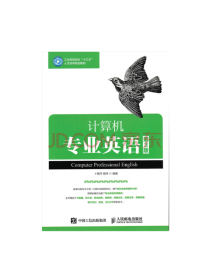编辑推荐
本书全面阐述12大领域计算机科学知识,强调实用性、可用性,并提升英文应用能力。
内容简介
本书共有十二章的内容,包括:计算机科学简介、计算机体系结构及网络、操作系统、算法、数据结构和软件工程、数据库及信息检索、人工智能、计算机图形学和可视化、计算机视觉、信息安全、人机交互、科学讲座及写作、职业及求学申请。本书具有系统性、可用性、实用性强、信息量和词汇量大等特点,为科技阅读和写作奠定坚实基础,并培养科学讲座、写作及学业和职位申请等英文应用能力。
章节目录
封面页
书名页
版权页
内容简介
前言
出版说明
目录
Chapter 1 Introduction of Computer Science
1.1 History of Computer Science
1.2 Areas of Computer Science
1.2.1 Theoretical Computer Science
1.2.2 Applied Computer Science
1.3 Is Computer Science Science?
1.3.1 Common Understandings of Science
1.3.2 Internal Disagreement
1.3.3 Computer Science Thrives on Relationships
1.3.4 Validating Computer Science Claims
1.4 The Future of Computer Science
1.4.1 Introduction
1.4.2 Innovative Research Projects
1.4.3 Theoretical Foundation
1.4.4 An Interview
1.5 Key Terms and Review Questions
1. Technical Terms
2. Translation Exercises
References
Chapter 2 Computer Architecture and Networks
2.1 Introduction
2.1.1 Computer Architecture
2.1.2 Design Goals
2.2 Computer System
2.2.1 Hardware
2.2.2 Software
2.3 Computer Networking
2.3.1 Network Hardware
2.3.2 Network Protocols
2.3.3 Internet and TCP/IP
2.4 Wireless Network
2.4.1 Wireless LAN Networking Basics
2.4.2 Mobile Network
2.4.3 Wireless Sensor Network
2.5 Key Terms and Review Questions
1. Technical Terms
2. Translation Exercises
References
Chapter 3 Operating System
3.1 Definition and Function
3.1.1 What is Operating System?
3.1.2 Functions of Operating System
3.1.3 Types of Operating Systems
3.2 Tasks of an Operating System
3.2.1 Processor Management
3.2.2 Process Management
3.2.3 Memory and Storage Management
3.2.4 Device Management
3.2.5 Application Interface
3.2.6 User Interface
3.3 Examples of Popular Modern Operating Systems
3.3.1 UNIX and UNIX-like Operating Systems
3.3.2 Microsoft Windows
3.4 Comparison of Windows and UNIX Environments
3.5 Key Terms and Review Questions
References
Chapter 4 Algorithms, Data Structures and Software Engineering
4.1 Algorithm
4.1.1 Introduction
4.1.2 Definition of Algorithms
4.1.3 Specifying Algorithms
4.1.4 Examples — Sorting Algorithms
4.1.5 Algorithm Analysis
4.2 Data Structures
4.2.1 Definition
4.2.2 Types of Data Structure
4.3 Programming
4.3.1 Evolution of Programming Language
4.3.2 Basic Components and Structure of a Program
4.3.3 Object-oriented Programming
4.4 Software Engineering
4.4.1 Life Cycle of Software
4.4.2 Software Development Models
4.4.3 Software Quality Characteristics
4.5 Key Terms and Review Questions
References
Chapter 5 Databases and Information Retrieval
5.1 Database System
5.1.1 Database
5.1.2 Relational Database
5.1.3 Database Management System
5.1.4 SQL
5.2 Information Retrieval
5.2.1 Introduction
5.2.2 An Example of Information Retrieval
5.2.3 Open Source IR System
5.2.4 Performance Measure
5.3 Web Search Basics
5.3.1 Background and History
5.3.2 Web Search Features
5.3.3 Web Crawling and Indexes
5.4 Key Terms and Review Questions
References
Chapter 6 Artificial Intelligence
6.1 Introduction
6.1.1 History of AI
6.1.2 Research Branches of AI
6.2 Turing Test
6.2.1 Introduction
6.2.2 Alan Turing
6.2.3 Inception of the Turing Test
6.2.4 Problems/Difficulties with the Turing Test
6.2.5 The Current State of the Turing Test
6.2.6 Artificial Intelligence Computer System Passes Visual Turing
6.3 Knowledge Representation and Reasoning
6.3.1 How to Represent Knowledge
6.3.2 Representation
6.3.3 Reasoning about Knowledge
6.3.4 KBS
6.3.5 MYCIN—A Case Study
6.4 Case-based Reasoning
6.4.1 Introduction
6.4.2 Fundamental of Case-based Reasoning
6.4.3 The CBR Process
6.4.4 Example-based Machine Translation
6.5 Robotics
6.5.1 Components of Robot
6.5.2 Control System
6.5.3 Environmental Interaction and Navigation
6.5.4 Top 10 Humanoid Robots
6.6 Computer Vision
6.6.1 Brief Introduction
6.6.2 Tasks of Computer Vision
6.6.3 An Example — Facial Recognition System
6.7 Existential Risk from Artificial General Intelligence
6.7.1 Overview
6.7.2 Risk Scenarios
6.7.3 Different Reactions on the Thesis
6.8 Key Terms and Review Questions
References
Chapter 7 Computer Graphics and Visualization
7.1 Computer Graphics
7.1.1 What Is Computer Graphics
7.1.2 Types of Graphics
7.1.3 Techniques Used in CG
7.1.4 Computer-aided Design
7.1.5 3D Modeling
7.2 Virtual Reality
7.2.1 What Is Virtual Reality
7.2.2 Types of Virtual Reality
7.2.3 Equipment Used in Virtual Reality
7.2.4 Applications of Virtual Reality
7.2.5 Pros and Cons of Virtual Reality
7.3 Data Visualization
7.3.1 Characteristics of Effective Graphical Displays
7.3.2 Quantitative Messages
7.3.3 Visual Perception and Data Visualization
7.3.4 Examples of Diagrams Used for Data Visualization
7.4 Key Terms and Review Question
References
Chapter 8 Human-Computer Interaction
8.1 Human-Computer Interaction
8.1.1 History of HCI
8.1.2 From Cabal to Community
8.1.3 Beyond the Desktop
8.1.4 The Task-artifact Cycle
8.1.5 A Caldron of Theory
8.1.6 Implications of HCI for Science, Practice, and Epistemology
8.2 User Interface Design Adaptation
8.2.1 Introduction
8.2.2 User Interface/Task/Platform Relations
8.2.3 Authoring Multi-Device Interactive Applications
8.2.4 Adaptation Rules
8.2.5 Model-based UI Design in Multi-Device Contexts
8.2.6 Vocal Interfaces
8.2.7 Multimodal User Interfaces
8.3 HRI
8.3.1 Introduction of HRI
8.3.2 HRI — About (not) Romanticizing Robots
8.3.3 HRI — There Is No Such Thing as “Natural Interaction”
8.3.4 HRI — There Is a Place For Non-humanoid Robots
8.4 Key Terms and Review Questions
References
Chapter 9 Computer Security
9.1 Computer Security Issues
9.1.1 Basic Security Concepts
9.1.2 Threats and Attacks
9.1.3 A Model for Network Security
9.2 Security Countermeasure
9.3 Cryptography
9.3.1 Basic Concepts
9.3.2 History of Cryptography
9.3.3 Modern Cryptography
9.4 Top 10 Cyber-security Issues in 2016
9.5 Cyberwar
9.5.1 A Cybersecurity Wargame Scenario
9.5.2 The First Casualty of Cyberwar Is The Web
9.5.3 Building Digital Armies
9.5.4 How Cyber Weapons Work
9.5.5 When Is a Cyberwar Not a Cyberwar?
9.5.6 The Targets in Cyberwar
9.5.7 Cyberwar: Coming to a Living Room Near You?
9.6 Key Terms and Review Questions
References
Chapter 10 Latest Progresses in Computer Science
10.1 Quantum Information Science
10.1.1 Quantum Computing
10.1.2 Quantum Cryptography
10.2 Deep Learning
10.2.1 Introduction
10.2.2 Historical Trends in Deep Learning
10.3 Cloud Computing
10.3.1 The Vision of Cloud Computing
10.3.2 Defining a Cloud
10.3.3 A Closer Look
10.3.4 The Cloud Computing Reference Model
10.4 Big Data
10.4.1 Let the Data Speak
10.4.2 Definition and Characteristic of Big Data
10.4.3 Value of Big Data
10.4.4 Risk of Big Data
10.5 Key Terms and Review Questions
References
附录CD
计算机专业英语是2019年由清华大学出版社出版,作者戚文静。
得书感谢您对《计算机专业英语》关注和支持,如本书内容有不良信息或侵权等情形的,请联系本网站。

















